
Édouard Manet was a French modernist painter. He was one of the first 19th-century artists to paint modern life, as well as a pivotal figure in the transition from Realism to Impressionism.
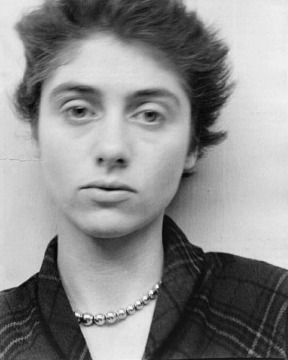
Diane Arbus was an American photographer. She photographed a wide range of subjects including strippers, carnival performers, nudists, people with dwarfism, children, mothers, couples, elderly people, and middle-class families. She photographed her subjects in familiar settings: their homes, on the street, in the workplace, in the park. "She is noted for expanding notions of acceptable subject matter and violates canons of the appropriate distance between photographer and subject. By befriending, not objectifying her subjects, she was able to capture in her work a rare psychological intensity." In his 2003 New York Times Magazine article, "Arbus Reconsidered", Arthur Lubow states, "She was fascinated by people who were visibly creating their own identities—cross-dressers, nudists, sideshow performers, tattooed men, the nouveaux riches, the movie-star fans—and by those who were trapped in a uniform that no longer provided any security or comfort." Michael Kimmelman writes in his review of the exhibition Diane Arbus Revelations, that her work "transformed the art of photography ". Arbus's imagery helped to normalize marginalized groups and highlight the importance of proper representation of all people.

Alfred Stieglitz was an American photographer and modern art promoter who was instrumental over his 50-year career in making photography an accepted art form. In addition to his photography, Stieglitz was known for the New York art galleries that he ran in the early part of the 20th century, where he introduced many avant-garde European artists to the U.S. He was married to painter Georgia O'Keeffe.

Ben Shahn was an American artist. He is best known for his works of social realism, his left-wing political views, and his series of lectures published as The Shape of Content.

Paul Strand was an American photographer and filmmaker who, along with fellow modernist photographers like Alfred Stieglitz and Edward Weston, helped establish photography as an art form in the 20th century. In 1936, he helped found the Photo League, a cooperative of photographers who banded together around a range of common social and creative causes. His diverse body of work, spanning six decades, covers numerous genres and subjects throughout the Americas, Europe, and Africa.

Jeffrey Wall, OC, RSA is a Canadian artist best known for his large-scale back-lit Cibachrome photographs and art history writing. Early in his career, he helped define the Vancouver School and he has published essays on the work of his colleagues and fellow Vancouverites Rodney Graham, Ken Lum, and Ian Wallace. His photographic tableaux often take Vancouver's mixture of natural beauty, urban decay, and postmodern and industrial featurelessness as their backdrop.
Uta Barth is a contemporary German-American photographer whose work addresses themes such as perception, optical illusion and non-place. Her early work emerged in the late 1980s and 1990s, "inverting the notion of background and foreground" in photography and bringing awareness to a viewer's attention to visual information with in the photographic frame. Her work is as much about vision and perception as it is about the failure to see, the faith humans place in the mechanics of perception, and the precarious nature of perceptual habits. Barth's says this about her art practice: “The question for me always is how can I make you aware of your own looking, instead of losing your attention to thoughts about what it is that you are looking at." She has been honored with two National Endowments of the Arts fellowships, was a recipient of the John Simon Guggenheim Fellowship in 2004‑05, and was a 2012 MacArthur Fellow. Barth lives and works in Los Angeles, California.

Joseph Stella was an Italian-born American Futurist painter best known for his depictions of industrial America, especially his images of the Brooklyn Bridge. He is also associated with the American Precisionist movement of the 1910s–1940s.

Charles Sheeler was an American artist known for his Precisionist paintings, commercial photography, and the avant-garde film, Manhatta, which he made in collaboration with Paul Strand. Sheeler is recognized as one of the early adopters of modernism in American art.
Martin Kippenberger was a German artist known for his extremely prolific output in a wide range of styles and media, superfiction as well as his provocative, jocular and hard-drinking public persona.
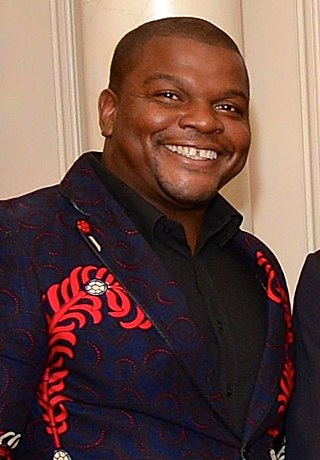
Kehinde Wiley is an American portrait painter based in New York City, who is known for his highly naturalistic paintings of Black people, frequently referencing the work of Old Master paintings. He was commissioned in 2017 to paint a portrait of former President Barack Obama for the Smithsonian National Portrait Gallery, which has portraits of all previous American presidents. The Columbus Museum of Art, which hosted an exhibition of his work in 2007, describes his work as follows: "Wiley has gained recent acclaim for his heroic portraits which address the image and status of young African-American men in contemporary culture."
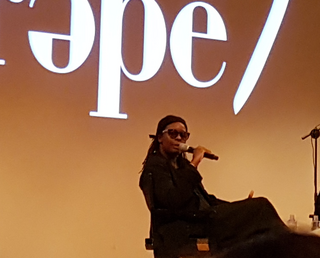
Mickalene Thomas is a contemporary African-American visual artist best known as a painter of complex works using rhinestones, acrylic, and enamel. Thomas's collage work is inspired from popular art histories and movements, including Impressionism, Cubism, Dada, the Harlem Renaissance, and selected works by the Afro-British painter Chris Ofili. Her work draws from Western art history, pop art, and visual culture to examine ideas around femininity, beauty, race, sexuality, and gender.

Water Lilies is a series of approximately 250 oil paintings by French Impressionist Claude Monet (1840–1926). The paintings depict his flower garden at his home in Giverny, and were the main focus of his artistic production during the last thirty years of his life. Many of the works were painted while Monet suffered from cataracts.
Collier Schorr is an American artist and fashion photographer best known for adolescent portraits that blend photographic realism with elements of fiction and youthful fantasy.
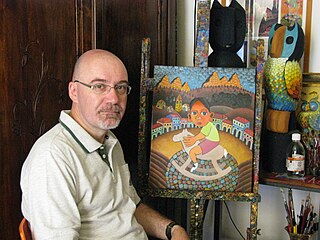
Guido Vedovato Italian naïve painter and sculptor.
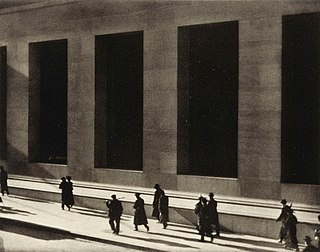
Wall Street is a platinum palladium print photograph by the American photographer Paul Strand taken in 1915. There are currently only two vintage prints of this photograph with one at the Whitney Museum of American Art and the other, along with negatives, at the Philadelphia Museum of Art. This photograph was included in Paul Strand, circa 1916, an exhibition of photographs that exemplify his push toward modernism.

Vincenzo Milazzo is an Italian naïve painter known for his use of reverse glass painting technique.
JoAnn Verburg is an American photographer. Verburg is married to poet Jim Moore, who is frequently portrayed as reading the newspaper or napping in her photographs. She lives and works in St. Paul, Minnesota and Spoleto, Italy.

Abstraction, Porch Shadows, also known as Abstraction, Porch Shadows, Twin Lakes, Connecticut, is a black and white photograph taken by Paul Strand in 1916. It is one of the best known photographs of his early phase, and shows the influence of cubism and abstractionism. It is considered one of the first abstract photographs ever made.

Balzac, the Open Sky is a black and white photograph taken by American photographer Edward Steichen in 1908. The photograph is part of a series created by Steichen that depict the statue of Honoré de Balzac by Auguste Rodin, executed in plaster, in 1898. The statue would eventually be cast in bronze and inaugurated in Paris, in 1939.
















